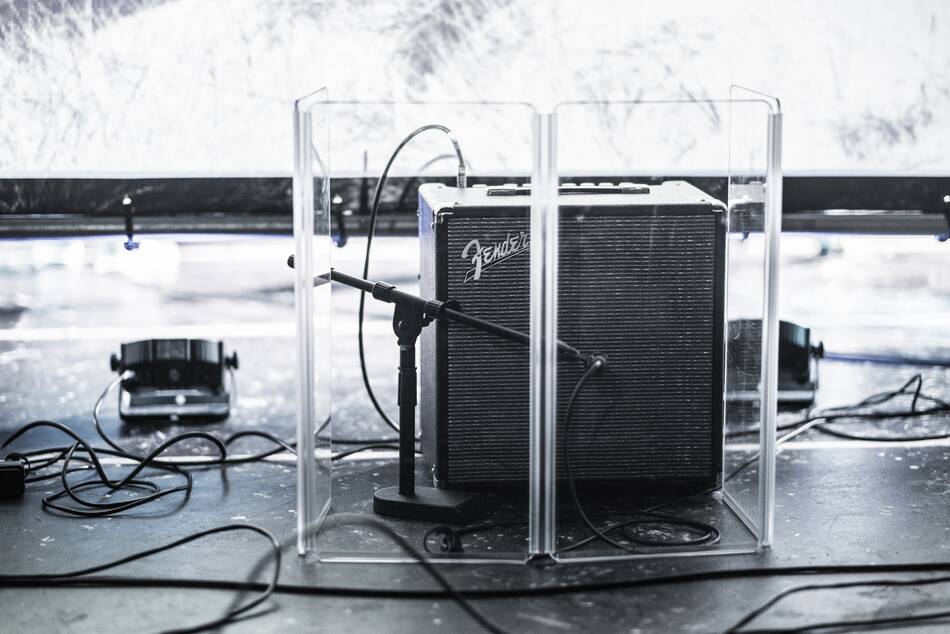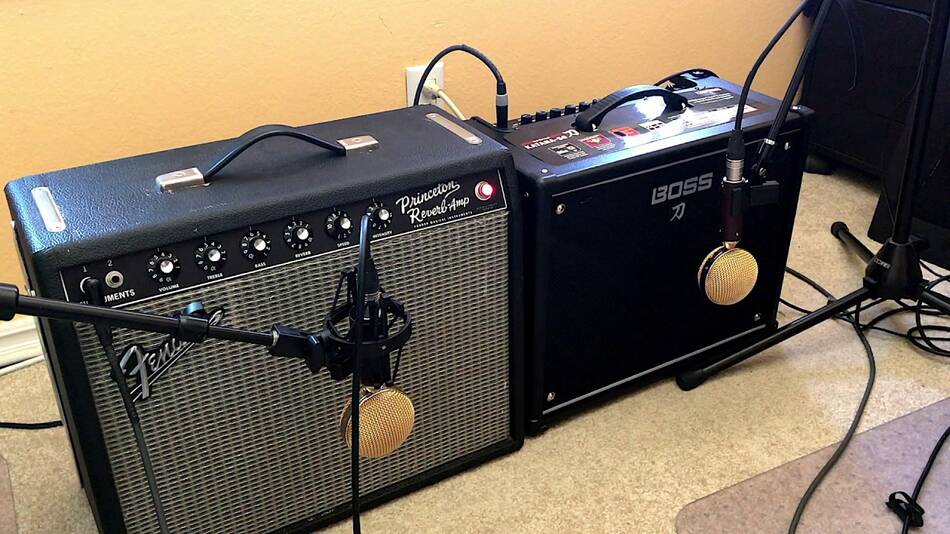
If you’ve always wondered whether guitar amps are mono or stereo, then you are not alone. Honestly, I’m surprised by the number of times I’ve seen this question asked in forums and Facebook groups, so I decided to answer it once and for all on this blog.
Are guitar amps stereo or mono? Most guitar amps available are mono, with a mono input port. That’s because guitars output a mono signal. However, there are a few guitar amps that are stereo. Stereo guitar amps usually have left and right stereo input ports for receiving stereo signals and two speakers to playback the stereo signal.
Those are the major points of this article captured in four sentences. However, we have a lot to cover in this article, so stick around if you want to learn more. We’ll talk about, in detail, why many guitar amp and cabs manufacturers decide to make mono amps. We’ll then take a look at stereo guitar amps, how they work, and two of the most popular options out there.
Later in the article, I’ll teach you how to run your guitar in stereo and the different ways to go about it. So let’s get into it.
Table of Contents
Why are Most Guitar Amps Mono?
Most guitar amps are mono because the guitar is a monophonic instrument. Since it was first built, electric guitars have always been a monophonic (or mono) instrument.
This means it outputs a mono signal. For those who don’t know what a mono signal is, this refers to an audio signal recorded from one source.
When you pluck a guitar string, the vibration of the string produces a sound wave. This sound wave is captured by the guitar pickups and converted into an electrical signal, which is mono.
Think of the pickups on a guitar as microphones. Although there is usually more than one pickup on a guitar, they are all treated as a single microphone that captures the guitar string’s sound wave. In essence, the signal picked up by the guitar pickups is a monophonic signal.
Few stereo electric guitars have been made in the past, but they were not as popular. The manufacturers were able to achieve the stereo effect by treating two different guitar pickups as separate sound sources.
One pickup’s audio signal is treated as the left channel, and the other pickup’s audio signal is treated as the right channel to get stereo output.
The Duelsonic Guitar is one of those stereo guitars which didn’t get as popular.
Enough about guitars! The whole point I’m trying to make is, every guitar you’ve heard in your favorite song or seen your favorite musician play is a mono instrument.
For this reason, it simply makes sense for every guitar amp manufacturer to make a mono guitar amp. From a business standpoint, producing more monophonic guitar amps will sell more. That’s because literally, everyone uses a guitar that outputs a mono signal. It also costs less to produce them
It’s more practical to make more mono guitar amps than stereo amps from a business point. Nonetheless, few companies have taken the bold step of making stereo guitar amps. Yes, they are not common, but they exist.
Stereo Guitar Amps
At this point, it has been made clear that guitars output a mono audio signal. So then, what’s the point of a stereo guitar amp? Especially if a mono signal will be run through it? Well, that’s far from the truth. And here’s the main reason why.
There are many guitar effects pedals that output a stereo signal. Many reverb, delay, and modulation effect pedals such as chorus, phaser, and flanger are stereo pedals.
These pedals receive the mono signal of the guitar, process it, and send it out as a stereo signal with the effects applied. So, if you want to playback the output of a stereo guitar effect pedal, you’ll need a stereo guitar amp.
That’s the only way you’ll get that wide and lush sound these effects pedal output. A mono guitar amp can’t play a stereo signal.
Stereo guitar amps usually have two inputs — one for the Left channel and the other for the Right channel. They will also have two speakers. This allows them to play these two signals separately.
Two of the most popular guitar amps available today are the Roland JC-40 Guitar (on Amazon) and the Fender Acoustic SFX II Acoustic Guitar Amp (also on Amazon)
Rolsand JC-40 is a classic emulation of Roland’s signature JC-120 sound that made waves in the early ’80s. But this is a stereo version of this classic amp.
Fender Acoustic SFX II, just as the name depicts, is a stereo acoustic guitar amp with several cool features including a microphone input and built-in effects.
The Problem With Stereo Guitar Amps
Stereo guitar amps are not so popular because of one issue. Both the left-channel and right-channel speaker is fixed in one speaker cabinet. They are very close together.
And due to this, you may not even hear the stereo effects. This is because the speakers are in the same cabinet, it sounds like one speaker playing.
To appreciate true stereo, one speaker should be on the left side of the listener, and the other speaker on the right side of the listener. This way, your ears will be able to perceive the difference in sound between the two speakers. And that is how you can truly hear and appreciate a stereo guitar sound.
This is the main issue of stereo guitar amps and one of the primary reasons why they’re not as popular.
Do You Need a Mono or Stereo Guitar Amp?
I must say, playing guitar in stereo sounds incredible. It sounds much bigger and wider and gives a sense of depth to the tone. But do you need a stereo guitar amp or you should probably stick with a mono amp?
Well, here are my two cents. If you are a solo artist and make guitar-oriented music or ambient music, it’s a good idea to have a stereo guitar amp. Your guitar will sound amazing with stereo effects and a stereo amp.
However, if you play in a band with multiple instrumentalists and vocalists, you should probably stick with a mono guitar amp. That’s because you don’t want your guitar to take up so much space in the music. Besides, you can still use many effects in mono to spice up your guitar sound anyway.
Let’s dive into how to run a guitar in stereo properly. You’re definitely going to pick up some helpful tips. Keep reading.
How to Run a Guitar in Stereo
Guitars are mono instruments, so to run them in stereo requires extra gear and technique. And that’s what we’ll talk about in this article. Here is how to do it.
1. Plug the guitar in a stereo effect pedal
Many people think splitting a guitar signal with a signal splitter will make it stereo. However, that’s far from accurate. What a signal splitter does is that it duplicates the guitar signal. Playing back two identical signals will only make it louder, and that’s not stereo.
For a true stereo signal, the audio signal on the left channel is slightly different from the right channel. And that is what stereo effect pedals do — they process the guitar’s mono signal and output two different audio signals to the left and right channels. This is what creates that wide realistic stereo effect.
So, long story short, to run a guitar in stereo, first, you need to run it through a stereo guitar effect pedal. There are tons of stereo effects available today. One of my favorites is the Eventide Space Reverb (on Amazon), which is arguably the only reverb effect pedal you’ll ever need in your guitar journey.
Multi-effect pedalboards such as the Line 6 Pod Go (Amazon) are also excellent stereo pedalboard that can give you a wide range of reverbs, delays, chorus, tremolo, and a whole lot of stereo effects you can run your guitar through.
2, Plug Stereo Output into a Guitar Amp
After the stereo effect pedal processes the guitar signal and turns it into a stereo signal, you need a way to listen to the stereo output. And there are two ways to go about this.
1. Use Two Guitar Amps

Before stereo guitar amps became a thing, guitar players have been running guitar in stereo for decades. They are able to do this by using two guitar amps. The stereo output’s left channel is plugged into one amp, and the right channel into another amp.
It’s best to use two identical guitar amps with the same settings to avoid any phasing issues. However, you can use different amps. Just make sure the signals are not canceling each other.
Once that’s done, you can record your stereo signal with two microphones, capturing each amp.
2. Use a Stereo Guitar Amp
The most cost-effective way to run guitar in stereo is to use a stereo guitar amp. This is exactly what a stereo guitar amp is designed for — to play stereo guitar audio signal.
You simply need to connect the left output channel of the effect pedal to the amp’s left input channel and the right output channel of the pedal to the right input channel of the amp with a ¼” TS/TRS cable.
You’ll save money on having to buy two amps. Also, it’s easier to travel with a single amp or cab than a double.
Conclusion
Typically, most guitar amps are mono because guitars are mono instrument. Now, manufacturers are making stereo guitar amps for guitar players who like to run their guitars in stereo without using two amps.
You should definitely go for a stereo guitar amp if you do ambient music guitar-oriented music. However, if you play in a band, you should go for a mono guitar amp

Hi, I’m Raymond. A keyboard player, music producer, and writer. And I’m also the founder of this blog. As someone who has been working with several audio and music equipment and different musicians for many years, my goal is to answer all your questions on music and equipment, as well as the latest music software and technology. For more info, check out my about me page

